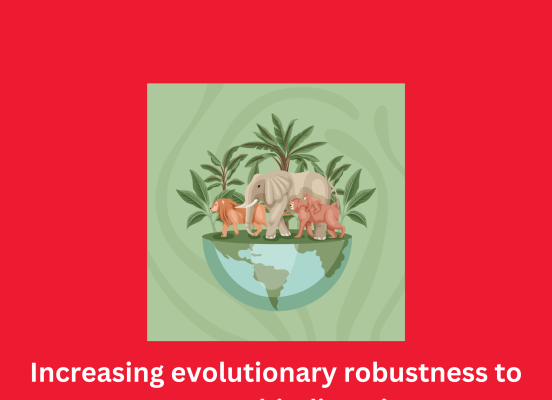
Increasing evolutionary robustness to preserve biodiversity in the face of climate change
- By admin --
- Monday, 08 Apr, 2024
Introduction
Natural populations are adapting to the converting international weather in a number of methods, inclusive of through converting the timing of existence cycle capabilities, shifting the geographic levels of species, or even changing environment interactions (Root et al. 2003; Parmesan 2006). Because species in ecological groups constrained to alpine areas and nearby damp wallet are not able to without difficulty migrate as weather turns into hotter and drier, these ecosystems are mainly susceptible to the effects of weather trade. As a end result, certain local regions' animals and flora are anticipated to enjoy high rates of extinction (Thomas et al. 2004). However, the likelihood of a species turning into extinct because of weather alternate may be extensively decreased if populations go through genetic mutations and are capable of adapt and expand in reaction to these predicted environmental changes.
Most ecologists now acknowledge that species can also evolve at very rapid costs, which could have an effect on the variety and abundance of a species. Several quick-lived species have already shown indicators of fast evolution in response to climate alternate (Reusch and Wood 2007), indicating that many organisms can be capable of adapt to adjustments in temperature inside tens of years (Bradshaw and Holzapfel 2008). The life of genetic variety in populations determines those reactions. There is now compelling evidence assisting a higher opportunity of extinction in natural populations in the absence of genetic range (Spielman et al. 2004). The lengthy-time period consequences cross up if genetic variety for adaptive evolution can be preserved and recovery techniques are implemented that aid in situ adaptive methods. A good deal past the ability of species to persist, with viable outcomes on atmosphere function and biodiversity (Bailey et al. 2009), in addition to resistance to catastrophic weather activities (Reusch et al. 2005).
Assessing genetic version and capability for evolution
Two styles of genetic diversity may be prominent. The basis of an organism's capacity to adapt to a brand new environment is its adaptive genetic variety. On the opposite hand, regions of the genome that are not situation to herbal choice are included in impartial genetic range. This sort of diversity is a result of populace dynamics and evolutionary procedures together with genetic flow, mutation, and migration. Even even as adaptive genetic diversity is essential for species to evolve and bear in changing settings, conservation biologists have mainly focused on the latter.
Although neutral variety is regularly hired to deduce a populace's ability for evolution, there may be commonly little correlation between the two (e.G., Reed and Frankham 2001; McKay and Latta 2002). Rather, it might be most desirable to at once take a look at this opportunity by gaining a understanding of the genetic variation related to an adaptive response (Hoffmann and Willi 2008). In the event that these genes are unknown, adaptive variation can be evaluated with the aid of assessing the heritability and evolvability— measures that directly indicate how genetically decided and changeable the functions below selection are. This necessitates measuring quantitative traits at some stage in numerous generations of an organism (typically parents and their progeny), ideally in comparable environmental settings (commonplace garden experiments, for example). Common garden experiments were used to evaluate the degrees of adaptive genetic diversity in numerous taxa, along with flora (Dorman et al.2009; Ramirez-Valiente et al. 2009), bugs (Crozier 2004; Klemme and Hanski 2009), and vertebrates (Johansson et al. 2007). However, those experiments are time-consuming and now not constantly possible for the focal species.
In a distinct studies, Joost et al. (2007) used a spatial analysis method to become aware of areas of the genome below natural choice by means of combining genetic records with environmental factors and geographic records structures (GIS). They looked at 57 sheep breeds from Europe and the Middle East as well as a broadly allotted species of pine weevil known as Hylobius abietis. Strong indicators were found linking some loci to environmental factors, that means that those loci did now not exhibit neutral behavior. This strategy has the capability to find possible instances of adaptive divergence throughout the levels of species and to locate genomic regions underneath selection with the aid of utilizing genome-huge scans of molecular markers over sizable geographic scales.
Genetic translocations: boosting adaptive capacity and protective towards extinction
Since genetic diversity has been lost in prone species due to habitat loss and fragmentation, maximum conservation efforts give attention to these species. These populations are fantastically prone to extinction, and there was developing discussion approximately the opportunity of assisted migration as a method of mitigating these threats (Hunter 2007; McLachlan et al. 2009; Swarts and Dixon 2009). Following pointers that intentional motion of species outdoor in their herbal (cutting-edge) variety have to be considered as an option for species at instant danger of extinction, a whole lot of the current debate has centered on shifting species past their present day variety (Hoegh-Guldberg et al. Although some very vulnerable species specially the ones in New Zealand have resorted to translocating individuals to locations outside in their present variety as a last resort (Jamieson et al. 2006; Miskelly et al. 2009), the subject remains quite contentious.
A in addition idea for a conservation method is to move individuals inside a species' gift variety by way of genetic translocation or aided migration which will facilitate gene drift and maintain or improve the adaptive capacity of the species. In the context of evolutionary resistance and climatic trade, genetic translocation might be taken into consideration in two different approaches. The first is associated with populations of inclined species whose genetic variety has been drastically reduced and wherein habitat fragmentation has interfered with dispersion mechanisms.





